I woke up all excited at four in the morning to head out to the Gibbon Wildlife Sanctuary near Kaziranga in Assam. You have to leave that early to get there in time for sightings.
The Gibbons are much smaller than the apes of Africa, and a little bigger than monkeys. At this place, they could only be seen on the upper branches of tall trees. They didn't come down and watching them strained my neck a bit. I had to keep looking up, balancing a heavy zoom lens on my eyes to ensure I caught the moments. They were mostly camouflaged by leaves and their complexion did not make photography easier. And when they would swing, they did so in the blink of an eye. But I did have fun following them for a few hours even though I had to keep removing leeches off me.
Here is an extract from the book Hoolock: The Ape of India by Dilip Chetry, Rekha Chetry and P.C. Bhattacharjee:
"We were on the way to try spot the Hoolock Gibbons. Of all the species of apes, these are the representatives of apes in India. They not only resemble the man in many ways but also share 95 per cent of genetic material with us.
Gibbons are the smallest of all apes and are close to humans in intelligence and social structure. Of 350 species of primates, Gibbons is represented by 16 species. The Hoolock Gibbon found in the northeast of India is one of them, and smaller than the Gorilla, Chimpanzee and Orangutan {Great Apes}. Gibbon is thus referred to as the Lesser Ape, or even the Small Ape. They are also more primitive than their great counterparts.
Being primates, Gibbons is also social in their behaviour and are unique in having a monogamous social structure {the same male and female spend their lives together}. They are also excellent acrobats. They dwell on canopies of forests and their longer forearms compared to the legs and bodies enable them to brachiate in the top strata of forests. Gibbons can brachiate at a speed of up to 55 kmph {35 mph} and move 20 feet {6 m} in one swing.
Gibbons are also protective of their home range, the area in which a family makes its habitat. Gibbons are frugivores – they eat fruits {ripe juicy ones} mostly, but also take in leaves, leaf buds, flowers, flower buds, petiole and animal protein {insects, bird eggs etc}."
The Gibbons are much smaller than the apes of Africa, and a little bigger than monkeys. At this place, they could only be seen on the upper branches of tall trees. They didn't come down and watching them strained my neck a bit. I had to keep looking up, balancing a heavy zoom lens on my eyes to ensure I caught the moments. They were mostly camouflaged by leaves and their complexion did not make photography easier. And when they would swing, they did so in the blink of an eye. But I did have fun following them for a few hours even though I had to keep removing leeches off me.
Here is an extract from the book Hoolock: The Ape of India by Dilip Chetry, Rekha Chetry and P.C. Bhattacharjee:
"We were on the way to try spot the Hoolock Gibbons. Of all the species of apes, these are the representatives of apes in India. They not only resemble the man in many ways but also share 95 per cent of genetic material with us.
Gibbons are the smallest of all apes and are close to humans in intelligence and social structure. Of 350 species of primates, Gibbons is represented by 16 species. The Hoolock Gibbon found in the northeast of India is one of them, and smaller than the Gorilla, Chimpanzee and Orangutan {Great Apes}. Gibbon is thus referred to as the Lesser Ape, or even the Small Ape. They are also more primitive than their great counterparts.
Being primates, Gibbons is also social in their behaviour and are unique in having a monogamous social structure {the same male and female spend their lives together}. They are also excellent acrobats. They dwell on canopies of forests and their longer forearms compared to the legs and bodies enable them to brachiate in the top strata of forests. Gibbons can brachiate at a speed of up to 55 kmph {35 mph} and move 20 feet {6 m} in one swing.
Gibbons are also protective of their home range, the area in which a family makes its habitat. Gibbons are frugivores – they eat fruits {ripe juicy ones} mostly, but also take in leaves, leaf buds, flowers, flower buds, petiole and animal protein {insects, bird eggs etc}."

